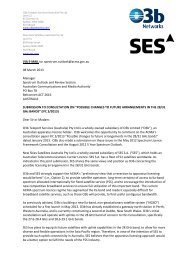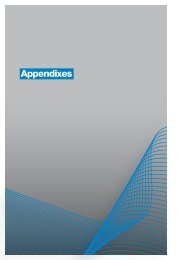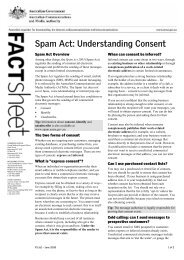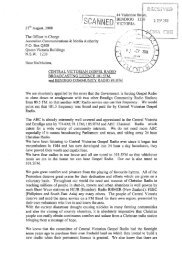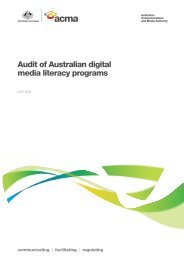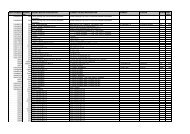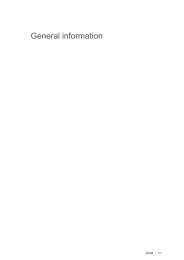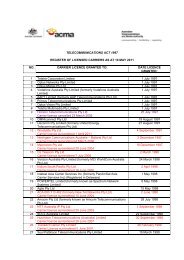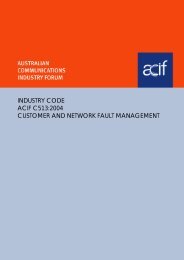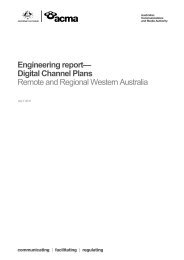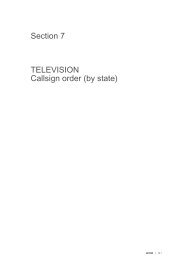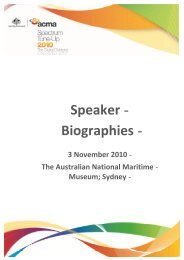Allocation of four community radio broadcasting licences for ... - ACMA
Allocation of four community radio broadcasting licences for ... - ACMA
Allocation of four community radio broadcasting licences for ... - ACMA
You also want an ePaper? Increase the reach of your titles
YUMPU automatically turns print PDFs into web optimized ePapers that Google loves.
The ABA notes that the ABS supports this view. The ABS found that the number <strong>of</strong><br />
people who reported being <strong>of</strong> Indigenous origin in Australia increased by 28.4%<br />
between 1991 and 1996. As a proportion <strong>of</strong> Victoria’s population, this represented an<br />
increase from 0.4% to 0.5% in Victoria. The ABS has projected the Indigenous<br />
population in Victoria in 2001 at 24,586. Given that the Indigenous population <strong>of</strong><br />
Melbourne comprises approximately half <strong>of</strong> the total Victorian Indigenous<br />
population, the ABA estimates the Indigenous population in Melbourne at<br />
approximately 12,000 in 2001.<br />
The ABA notes, however, that the Census size <strong>of</strong> the Indigenous <strong>community</strong> does<br />
not necessarily reflect the true listening audience <strong>of</strong> an Indigenous <strong>radio</strong> service. The<br />
ABA’s 1994 report entitled Listening to the Listeners – Radio Research found that<br />
interest in receiving an Indigenous <strong>radio</strong> service by people who perceived that they<br />
did not have access to one already was 2.0% in Melbourne, or 63,276 people in the<br />
Melbourne licence area.<br />
Christian <strong>community</strong><br />
Triple Seven proposes to serve the broader Christian <strong>community</strong> embracing<br />
churchgoers, non-churchgoers and those interested in spirituality. CBL proposes to<br />
represent the Catholic <strong>community</strong>.<br />
The 1996 Census indicates that 2,078,582 people identified as Christian in the<br />
Melbourne-wide licence area, or 65.7% <strong>of</strong> the licence population. The main Christian<br />
denomination was Catholic comprising 952,674 persons or 30% <strong>of</strong> the Melbourne<br />
population. The other main Christian denominations include Anglican (23%),<br />
Orthodox (9%), Uniting Church (8%) and Presbyterian (5%).<br />
There is currently no full time Christian <strong>broadcasting</strong> service in Melbourne. Most<br />
existing religious programming is confined to Sundays, or late evening/early<br />
morning time slots.<br />
Triple Seven refers to a survey conducted by NCLS Research in conjunction with<br />
Edith Cowen University <strong>of</strong> 8,500 respondents, which found that 438,047 Australian<br />
adults over 18 years (or 14% <strong>of</strong> the Melbourne licence area population) attended a<br />
service <strong>of</strong> worship at a Christian church at least monthly. Triple Seven claims that if<br />
children under 18 years were included church attendees are estimated to be 580,000.<br />
The study also found that 32% <strong>of</strong> Australians say spirituality is very important and<br />
34% say it is important to them.<br />
The ABA notes, however, that the Census size <strong>of</strong> the Christian <strong>community</strong> does not<br />
necessarily reflect the true listening audience <strong>of</strong> a Christian <strong>radio</strong> service. The<br />
ABA’s 1994 report entitled Listening to the Listeners – Radio Research found that<br />
interest in receiving a Christian <strong>radio</strong> service by people who perceived that they did<br />
not have access to one already was 2.3% in Melbourne, or 72,767 people in the<br />
Melbourne licence area.<br />
24



